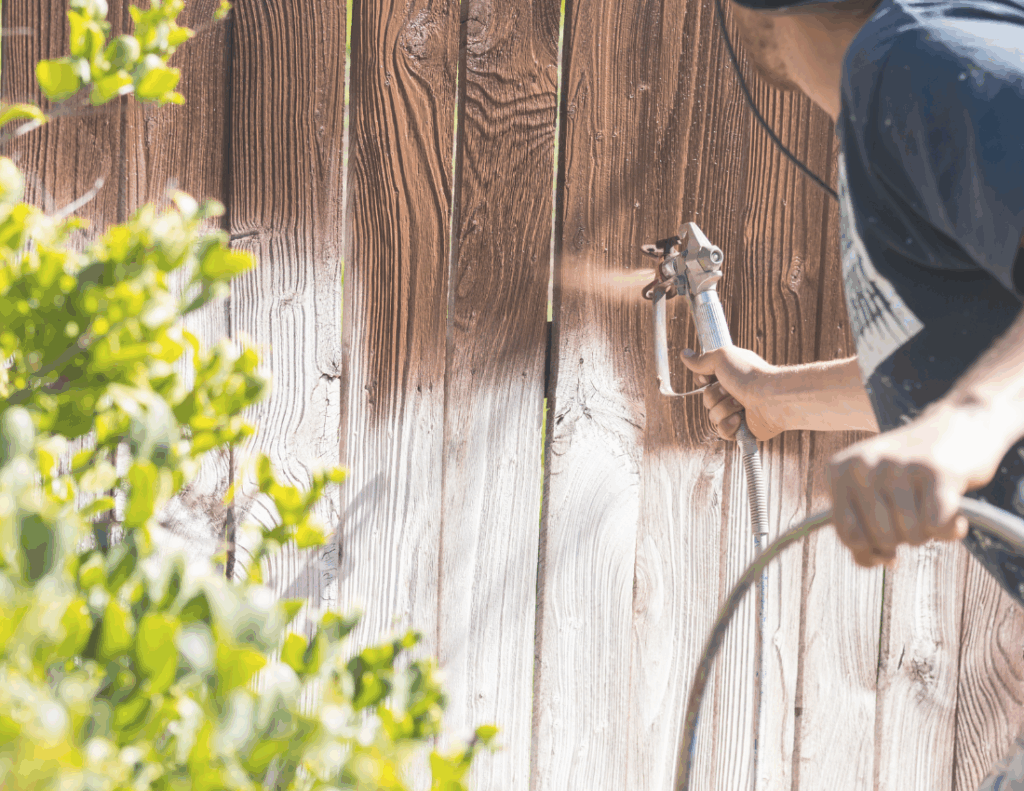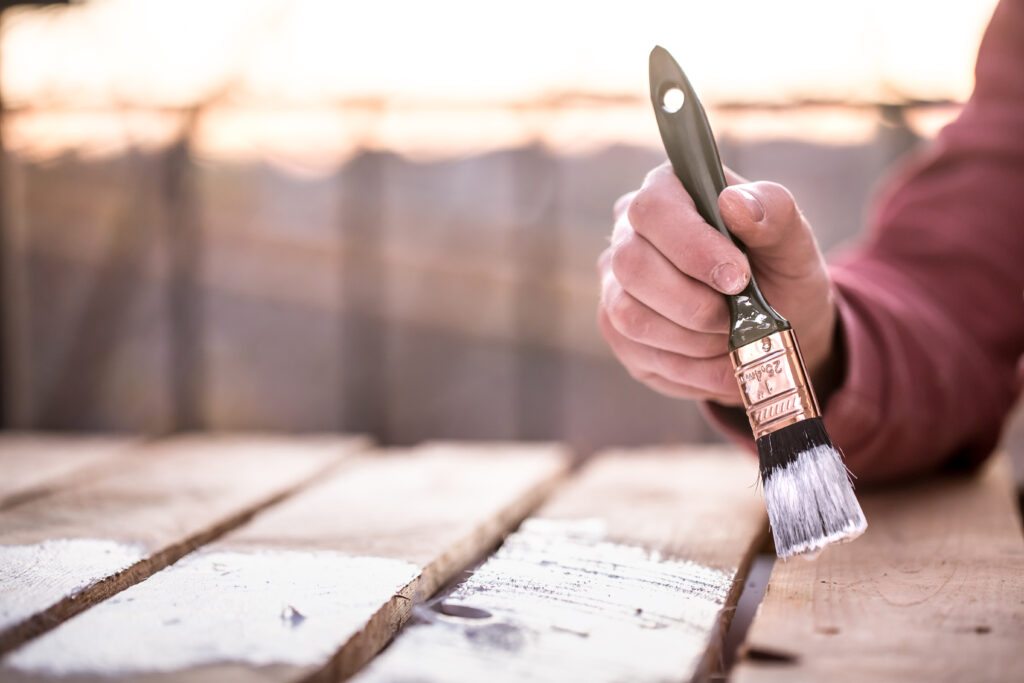If you’ve ever looked out at your backyard and thought, “Should I paint or stain my fence?” you’re not alone. Homeowners across Escondido face the same question, especially with the local climate that brings warm summers, occasional rain, and plenty of sun exposure.
Your fence is not just a boundary; it’s part of your home’s curb appeal and plays a role in protecting your property. Deciding whether to paint or stain can make a big difference in longevity, aesthetics, and maintenance.
As professional deck painters in Escondido, we’ve seen firsthand how the right choice can extend the life of wood, improve its look, and save you headaches later on. Let’s break down what you should know before making that decision.
Key Takeaways:
- Paint or stain my fence? Paint gives bold color but needs more prep; stain enhances wood grain and is easier to maintain.
- Longevity matters: Paint can last 5–6 years, while stain often needs reapplication every 3 years but wears more evenly.
- Climate plays a role: In Escondido, sun and rain impact finishes differently; stain often holds up better against moisture and mildew.
- Fence material affects choice: Cedar does best with stain, pressure-treated lumber can take both, and rough wood prefers oil-based stain.
- Professional deck painters in Escondido help homeowners avoid mistakes with the right prep, primer, and application for lasting results.

Paint or Stain My Fence: What’s the Difference?
Before choosing, it helps to understand the basic difference between the two.
- Paint sits on the surface of the wood, covering the natural wood grain and offering solid color choices.
- Stain penetrates into the wood, enhancing its natural look while still adding color and protection.
Both have pros and cons depending on what you want out of your fence. Some people want the clean look of paint while others prefer to highlight the wood grain with a stain.
The question “Should I paint or stain my fence?” usually comes down to your goals for style, durability, and how much upkeep you’re willing to commit to.
Appearance and Style Options
One of the most common reasons homeowners lean toward paint is the endless color options. If you want your fence to match your home’s trim, shutters, or even something bold, paint offers unlimited choices. From bright whites to deep blues, the spectrum is wide.
Stain, however, enhances the natural wood grain. Transparent or semi-transparent stains allow the beauty of cedar, pine, or redwood to shine through, while solid stains give you a painted look but with a softer finish.
If you’re someone who wants your fence to blend with natural surroundings or highlight the lumber itself, stain may be the better choice. If you prefer a sharp, uniform look that matches other parts of your home, paint has the advantage.
Related read: choosing between a roller painting vs spray painting technique can also affect how your fence looks and how evenly the finish goes on.
Durability and Longevity
Here in Escondido, the climate plays a huge role in how long your finish lasts. The sun, moisture, and even occasional mildew or mold can break down coatings over time.
- Paint generally lasts five to six years before needing a new coat. However, when it starts to wear, it often cracks, blisters, or peels. Once that happens, it requires sanding, scraping, and priming before you can repaint.
- Stain usually needs reapplication every three years, but it fades more gracefully. Instead of peeling, stain wears down evenly, making maintenance less labor-intensive.
If longevity is your main concern, remember that no finish is permanent. However, many deck painters in Escondido recommend stain for fences because it penetrates the wood, protecting against water and mildew while keeping the natural feel.
Maintenance Needs Over Time
When asking, “Should I paint or stain my fence?” it’s important to think about upkeep.
- Painted fences require more prep work when it’s time to refresh. Old paint has to be removed, the wood may need sanding with sandpaper, and a primer coat applied before repainting.
- Stained fences only need a proper wash to remove dirt, mildew, and water marks before reapplication.
Another thing to note: fences exposed to heavy rain or shaded areas that collect moisture may experience mildew growth. Stains with sealant often do a better job of protecting against this compared to paint.
For homeowners who want less hassle down the road, stain usually makes life easier. But if you love a specific color match and don’t mind extra maintenance, paint can still be a great option.
Weather Protection in Escondido
Escondido’s climate includes warm sun, dry spells, and the occasional rainy season. How your fence finish reacts to these elements matters.
- Paint creates a barrier on top of the wood, blocking water but sometimes trapping moisture inside if the wood wasn’t completely dry at application. This can lead to blistering or peeling.
- Stain soaks into the wood, allowing it to breathe while still offering protection against rain and moisture. Oil-based stains in particular resist water and mold well, making them popular for exterior wood like fences and decks.
If you’re considering pressure-treated lumber for fence installation, stain might be better because it bonds more naturally with the surface once the wood has dried. For cedar fences, stain is highly recommended since paint doesn’t adhere well and can shorten the lifespan of cedar.
For decks or outdoor furniture in Escondido, professional painters often choose stain to withstand moisture, mildew, and water exposure without heavy wear.
Cost Comparison
Many homeowners assume paint is cheaper because a gallon of exterior paint costs less than a gallon of quality stain. While that’s true upfront, paint usually requires more materials: primer, additional coats, and sometimes a sealant.
Stain is more expensive per gallon but typically requires fewer coats and less prep work. Over the life of the fence, the costs often even out. The bigger factor is how much maintenance you’re comfortable with over the years.
For those budgeting their exterior projects, using a paint calculator can help estimate product amounts, but remember that application, prep, and long-term maintenance play just as big of a role in cost as the upfront purchase.
Application Differences
Applying paint and stain isn’t the same process. Professional deck painters in Escondido know that:
- Paint requires careful prep, smoothing with sandpaper, and multiple coats for proper coverage. Brushes and sprayers both work, but technique matters to avoid drips and uneven coats.
- Stain can be applied with a sprayer or brush and is generally more forgiving since it penetrates instead of sitting on the surface. It also dries faster under the right climate conditions.
If you want a fence that looks crisp, paint offers sharper results. If you want natural grain and less visible wear, stain provides that flexibility.
Choosing the wrong method or skipping steps can lead to painting mistakes that shorten the lifespan of your finish.
Fence Material Considerations
Not all fences respond the same way to paint or stain.
- Cedar: Best left stained or sealed with oil; paint can reduce longevity.
- Pressure-treated lumber: Can be painted or stained but must dry thoroughly before treatment. Stain won’t penetrate as deeply in treated wood.
- Rough-sawn wood: Better suited for an oil-based stain or solvent-based treatment to preserve its natural look.
Matching the right finish to your lumber type is just as important as choosing color. This ensures the fence not only looks good but stands up to Escondido’s climate.
Customization and Curb Appeal
Your fence is one of the first things people notice when they drive by your property. The finish you choose impacts aesthetics and value.
- Paint gives bold color, making your fence stand out. If you want a picket fence in bright white, paint is the classic choice.
- Stain gives a more natural, timeless look, especially when combined with other wooden elements like decks, pergolas, or outdoor furniture.
Adding pigment or choosing solid stain colors can help bridge the gap if you want both color variety and natural texture.
Conclusion: Should I Paint or Stain My Fence in Escondido?
At the end of the day, the decision comes down to what matters most: color customization, ease of maintenance, or highlighting natural wood. If you’re in Escondido and asking “Should I paint or stain my fence?”, here’s the bottom line:
- Paint offers endless colors and bold curb appeal but requires more prep and maintenance.
- Stain enhances wood grain, resists mildew and water, and is easier to maintain long-term.
- Your choice depends on the wood type, climate conditions, and how much upkeep you’re comfortable with.
As experienced deck painters in Escondido, Lifetime Custom Painting helps homeowners choose finishes that match their property style while standing up to local weather.
Ready to decide whether to paint or stain your fence? Call us at 619-389-2118 for a FREE estimate and let us bring your fence back to life.



